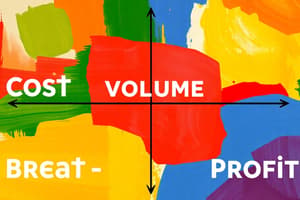Podcast
Questions and Answers
A company has fixed costs of $50,000 and a per-unit contribution margin of $25. If they sell 3,000 units, what will be the company's profit or loss?
A company has fixed costs of $50,000 and a per-unit contribution margin of $25. If they sell 3,000 units, what will be the company's profit or loss?
- Profit of $75,000
- Break-even
- Loss of $25,000
- Profit of $25,000 (correct)
Which of the following is NOT a typical application of break-even analysis?
Which of the following is NOT a typical application of break-even analysis?
- Analyzing the effect of price changes on sales volume needed to break even.
- Evaluating the impact of changes in fixed costs on profitability.
- Assessing the feasibility of introducing a new product.
- Determining the optimal inventory level to minimize carrying costs. (correct)
What is the impact on the break-even point in units if the fixed costs increase, while the selling price and variable costs remain constant?
What is the impact on the break-even point in units if the fixed costs increase, while the selling price and variable costs remain constant?
- The break-even point remains the same.
- The break-even point decreases.
- The impact on the break-even point cannot be determined.
- The break-even point increases. (correct)
In a break-even chart, what does the intersection of the total revenue line and the total cost line represent?
In a break-even chart, what does the intersection of the total revenue line and the total cost line represent?
A company decreases its selling price per unit. Assuming no changes in fixed costs or variable costs, what is the likely impact on the break-even point in units?
A company decreases its selling price per unit. Assuming no changes in fixed costs or variable costs, what is the likely impact on the break-even point in units?
A business has the following data: Selling price per unit = $50, Variable cost per unit = $30, Fixed costs = $100,000. What is the break-even point in units?
A business has the following data: Selling price per unit = $50, Variable cost per unit = $30, Fixed costs = $100,000. What is the break-even point in units?
Which of the following costs is LEAST likely to be considered a fixed cost?
Which of the following costs is LEAST likely to be considered a fixed cost?
What does the contribution margin ratio represent?
What does the contribution margin ratio represent?
How does an increase in variable costs per unit affect the break-even point in sales dollars, assuming all other factors remain constant?
How does an increase in variable costs per unit affect the break-even point in sales dollars, assuming all other factors remain constant?
For a company with high operating leverage (high fixed costs relative to variable costs), what is the implication for profitability once the break-even point is reached?
For a company with high operating leverage (high fixed costs relative to variable costs), what is the implication for profitability once the break-even point is reached?
Which of the following scenarios would result in a DECREASE in the break-even point in units?
Which of the following scenarios would result in a DECREASE in the break-even point in units?
A retailer sells each product for $25. The retailer purchases these products for $10 each. The retailer also has monthly fixed costs of $3,000. How many products does the retailer need to sell each month to break even?
A retailer sells each product for $25. The retailer purchases these products for $10 each. The retailer also has monthly fixed costs of $3,000. How many products does the retailer need to sell each month to break even?
What is the formula to calculate break-even point in sales dollars?
What is the formula to calculate break-even point in sales dollars?
Which is an example of a variable cost?
Which is an example of a variable cost?
What does the break-even point signify with respect to profit and loss?
What does the break-even point signify with respect to profit and loss?
What is the role of break-even analysis in pricing strategies?
What is the role of break-even analysis in pricing strategies?
When a company performs a break-even analysis for a new product, what does this analysis primarily help the company determine?
When a company performs a break-even analysis for a new product, what does this analysis primarily help the company determine?
How can understanding the break-even point assist in overall financial strategy?
How can understanding the break-even point assist in overall financial strategy?
What is the primary focus of break-even analysis?
What is the primary focus of break-even analysis?
Flashcards
Break-even Point
Break-even Point
Point where total revenue equals total costs; no net profit or loss occurs.
Variable Costs
Variable Costs
Costs that change in direct proportion to the level of production or sales.
Fixed Costs
Fixed Costs
Costs that remain constant regardless of production or sales volume within a relevant range.
Break-even Point in Units Formula
Break-even Point in Units Formula
Signup and view all the flashcards
Break-even Point in Sales Dollars Formula
Break-even Point in Sales Dollars Formula
Signup and view all the flashcards
Contribution Margin Ratio
Contribution Margin Ratio
Signup and view all the flashcards
Break-even Graph
Break-even Graph
Signup and view all the flashcards
Break-even Analysis
Break-even Analysis
Signup and view all the flashcards
Per-Unit Contribution Margin
Per-Unit Contribution Margin
Signup and view all the flashcards
Break-even Definition
Break-even Definition
Signup and view all the flashcards
Study Notes
- Break-even analysis is a crucial tool for businesses to determine the point at which total revenue equals total costs
- At the break-even point, a company experiences no net profit or loss
- Understanding the break-even point helps in making informed decisions about pricing, production, and overall financial strategy
- The break-even point can be expressed in units or revenue (sales)
- Break-even analysis helps businesses determine the level of sales needed to cover all costs
- It is used in business planning, cost management, and pricing strategies
Calculating Break-even Point
- The break-even point can be calculated using formulas based on costs and revenue
- The formula to calculate break-even point in units is: Fixed Costs / (Sales Price per Unit - Variable Cost per Unit)
- The formula to calculate break-even point in sales dollars is: Fixed Costs / ((Sales Price per Unit - Variable Cost per Unit) / Sales Price per Unit) which is equivalent to Fixed Costs / Contribution Margin Ratio
- Contribution Margin Ratio = (Sales Price per Unit - Variable Cost per Unit) / Sales Price per Unit
- The per-unit contribution margin represents the amount each unit sold contributes towards covering fixed costs
- The break-even point in units indicates how many units must be sold to cover all costs
Variable Vs Fixed Costs
- Costs are generally classified into two main categories: variable costs and fixed costs
- Variable costs change in direct proportion to the level of production or sales
- Examples of variable costs include raw materials, direct labor, and sales commissions
- Fixed costs, on the other hand, remain constant regardless of the production or sales volume within a relevant range
- Examples of fixed costs include rent, salaries, and insurance
- Identifying and segregating fixed and variable costs is essential for break-even analysis
- Accurate classification of costs impacts the calculation of the break-even point
Graphical Representation
- The break-even point can be visually represented on a graph
- Typically, the graph plots total costs and total revenues against the number of units produced or sold
- The point where the total revenue line intersects the total cost line represents the break-even point
- The area below the break-even point represents a loss
- The area above the break-even point represents a profit
- The graph provides a clear visual depiction of the relationship between costs, revenue, and profitability
- A break-even chart typically includes fixed costs represented as a horizontal line
Concept Definition
- Break-even analysis is a financial tool used to determine the stage at which a company, or a new service or a product, will be profitable
- It is a calculation to determine what volume of sales will result in a break-even
- Also known as cost-volume-profit (CVP) analysis
- Break-even analysis focuses on the relationship between fixed cost, variable cost, and revenue
- A break-even point is when total costs equal total revenue
- Break-even analysis can be used to analyze the potential profitability of a new product
- It can help a company determine the level of output required to make a new product profitable
- It also helps companies to analyse pricing strategies
- By understanding the break-even point, companies can determine whether its feasible to sell products at a price point
Studying That Suits You
Use AI to generate personalized quizzes and flashcards to suit your learning preferences.




